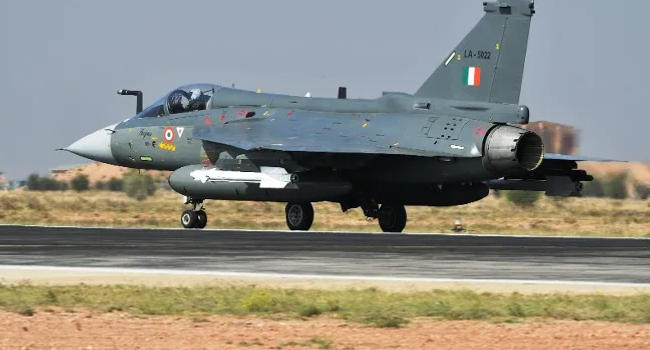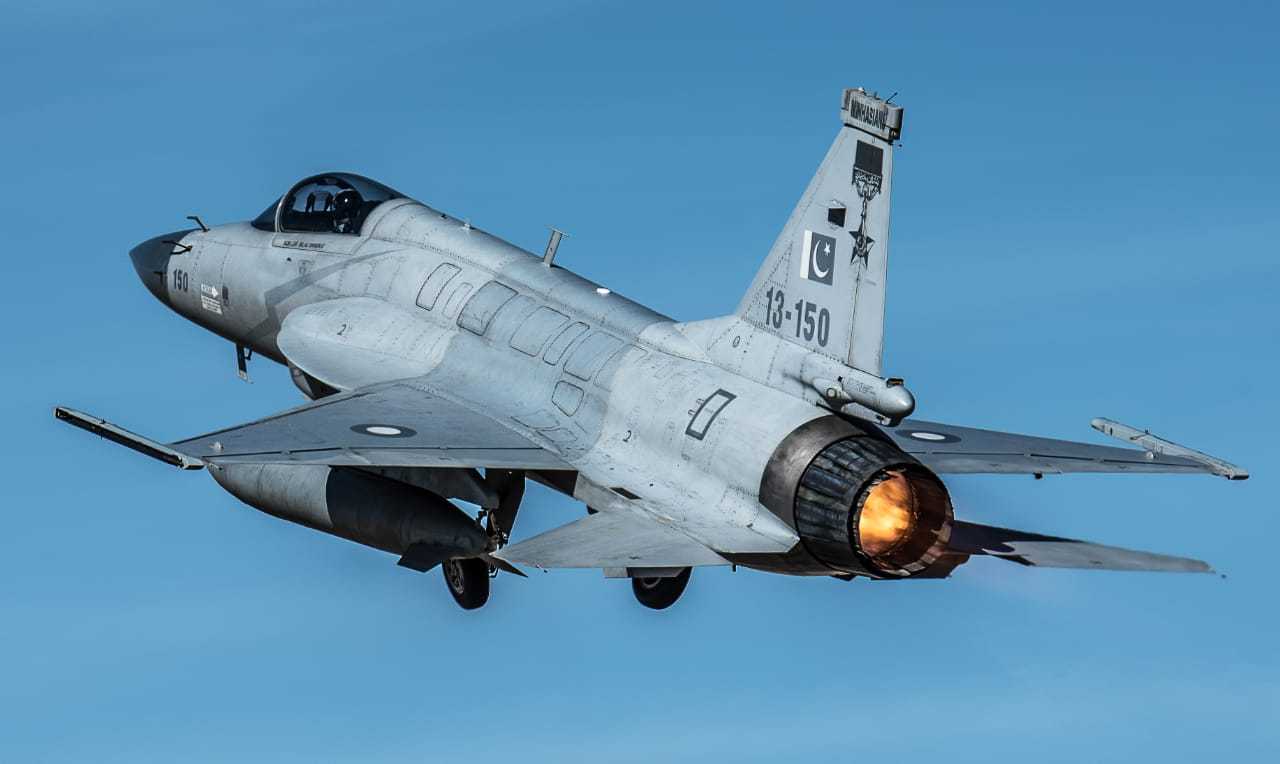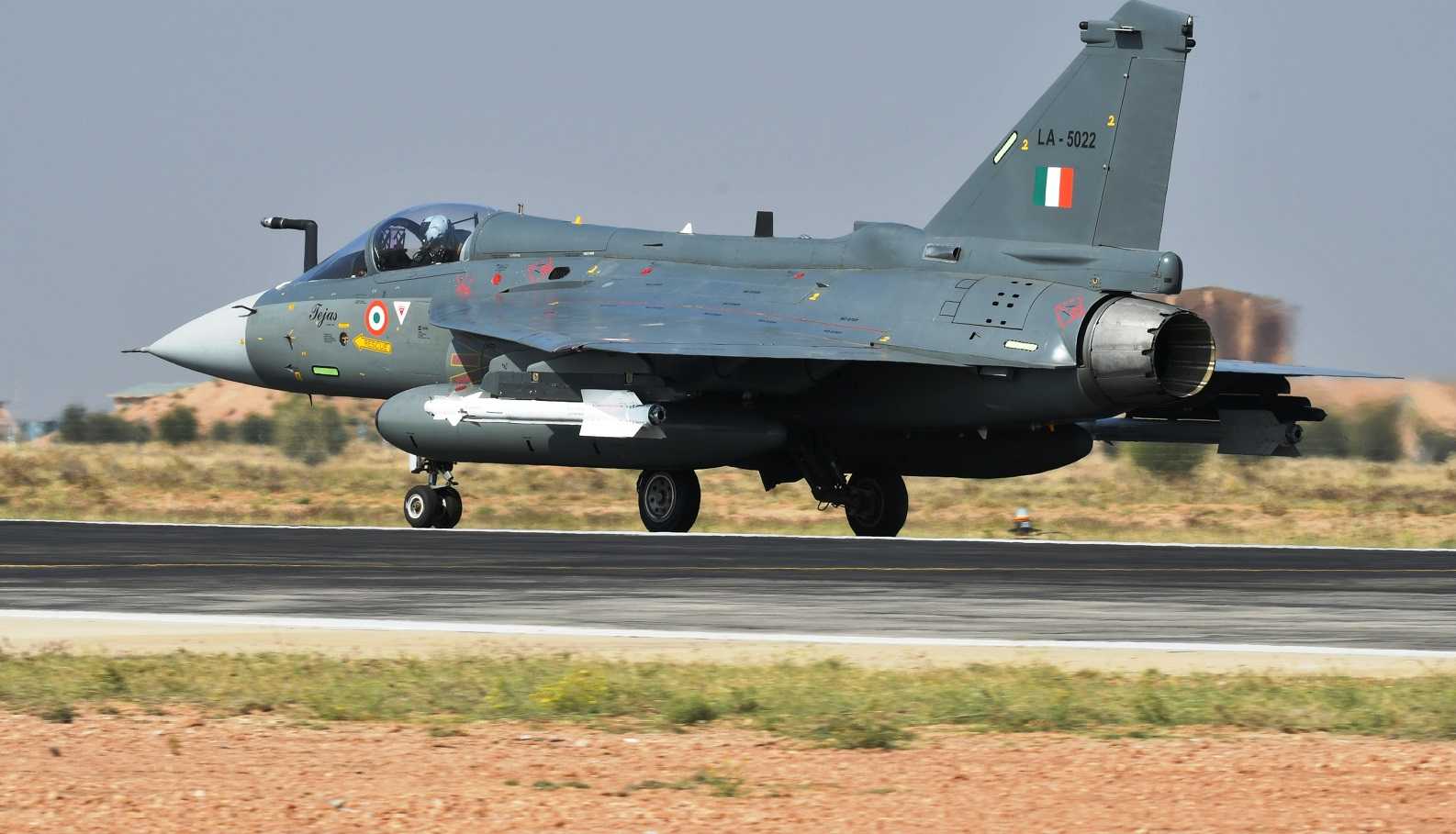Published 15:25 IST, November 12th 2023
Regional rivals IAF’s LCA Tejas and Chinese made JF-17s to face-off at Dubai Airshow
India's Tejas, China's J-10C, and Pakistan's JF-17 are set to feature at Dubai Airshow, presenting a regional fighter jet spectacle.

'%20fill='white'/%3e%3cg%20id='1200px'%3e%3crect%20width='1200'%20height='382'%20transform='translate(-829%20-9348)'%20fill='white'/%3e%3cg%20id='Home%20Page%20Content'%3e%3crect%20width='1905'%20height='30990.4'%20transform='translate(-1181.5%20-8954)'%20fill='white'/%3e%3cg%20id='Debate%20Quicks%20+%20Poll'%20clip-path='url(%23clip0_115_35629)'%3e%3crect%20width='1224'%20height='492'%20transform='translate(-841%20-3)'%20fill='white'/%3e%3cg%20id='Entertainment%20Quicks'%3e%3cg%20id='Header+Content'%3e%3cg%20id='Section%20Header'%3e%3crect%20width='379'%20height='44'%20transform='translate(-8%20-4)'%20fill='%23A20010'/%3e%3cg%20id='Section%20Name'%3e%3cg%20id='R.logo'%20clip-path='url(%23clip1_115_35629)'%3e%3cg%20id='R.'%3e%3cg%20id='Group'%3e%3cpath%20id='Vector'%20d='M39.3895%200H0.619814C0.279658%200%200.00390625%200.275754%200.00390625%200.61591V35.3841C0.00390625%2035.7242%200.279661%2036%200.619817%2036H39.3895C39.7297%2036%2040.0054%2035.7242%2040.0054%2035.3841V0.615908C40.0054%200.275751%2039.7297%200%2039.3895%200Z'%20fill='%23D10014'/%3e%3cpath%20id='Vector_2'%20d='M33.1603%2031.2711C35.2153%2031.0652%2036.7155%2029.2199%2036.5111%2027.1495C36.3067%2025.0792%2034.4751%2023.5677%2032.4201%2023.7736C30.3651%2023.9796%2028.8649%2025.8249%2029.0693%2027.8952C29.2737%2029.9656%2031.1053%2031.4771%2033.1603%2031.2711Z'%20fill='white'/%3e%3cpath%20id='Vector_3'%20d='M5.17188%205.62891H17.2328C21.1319%205.62891%2023.8278%206.65659%2025.5407%208.41892C27.0347%209.88754%2027.7996%2011.8696%2027.7996%2014.4026V14.4758C27.7996%2018.4041%2025.7224%2021.0103%2022.5525%2022.3683L28.6379%2031.3258H20.4761L15.3381%2023.5432H12.2409V31.3258H5.17188V5.62891ZM16.9049%2017.9632C19.3099%2017.9632%2020.6942%2016.7883%2020.6942%2014.9161V14.8428C20.6942%2012.8241%2019.2365%2011.7957%2016.8685%2011.7957H12.2409V17.9632H16.9049Z'%20fill='white'/%3e%3c/g%3e%3c/g%3e%3c/g%3e%3c/g%3e%3c/g%3e%3c/g%3e%3c/g%3e%3c/g%3e%3c/g%3e%3c/g%3e%3c/g%3e%3cdefs%3e%3cclipPath%20id='clip0_115_35629'%3e%3crect%20width='1224'%20height='492'%20fill='white'%20transform='translate(-841%20-3)'/%3e%3c/clipPath%3e%3cclipPath%20id='clip1_115_35629'%3e%3crect%20width='40.0015'%20height='36'%20fill='white'/%3e%3c/clipPath%3e%3c/defs%3e%3c/svg%3e) Big Data
Big Data
Dubai Airshow 2023
The Dubai Airshow 2023 is poised to witness a spectacular showcase of aviation prowess as India's Tejas fighter jets, China's J-10C Vigorous Dragon, and Pakistan's JF-17 Thunder Block-3 prepare to dazzle audiences from November 13 to 17 at Dubai World Central.
The Indian Air Force has confirmed the arrival of the indigenously produced LCA Tejas aircraft at Al Maktoum International Airport in Dubai. Three Tejas fighter aircraft will be the highlight, participating in both static displays and dynamic aerial performances throughout the airshow. This marks a significant moment for India, showcasing the capabilities of its advanced indigenous fighter jet on the global stage.
JF-17's uncertain appearance
The participation of Pakistan's JF-17 Thunder Block-3 remains officially unconfirmed. Despite this, the Dubai Airshow's website has listed the Pakistani fighter aircraft in the lineup, suggesting a potential direct comparison with the Indian Tejas in the flying display. The uncertainty adds an element of anticipation, and if the JF-17 takes to the skies, it promises an intriguing showdown between the regional rivals.
China's J-10C Vigorous Dragon, a medium-weight fighter aircraft, is set to make its debut at the Dubai Airshow. Seven jets from the Chinese Air Force's August 1st Aerobatics Team will grace the event, marking their return since 2017. The J-10C's appearance also signifies its inaugural public display in the Middle East post a significant upgrade in 2018, adding an element of novelty to the airshow.
History of rivalry
The Tejas and JF-17, often viewed as rivals on the global stage, have a history of competing in various international bids. However, the JF-17, a Sino-Pakistani collaboration, has exhibited a tendency to withdraw from international airshows where it was supposed to showcase alongside India's Tejas. This pattern, noted at events like the Bahrain Air Show in 2016 and Malaysia's LIMA in 2019, raises questions about a deliberate avoidance of direct comparisons.
In a joint venture between China's Chengdu Aircraft Corporation and Pakistan Aeronautical Complex, the JF-17 Thunder has solidified its position as the workhorse of the Pakistan Air Force (PAF). Designed to replace several aging combat aircraft, including the F-7P/PG and Mirage series, the JF-17 boasts multi-role capabilities, cost-effectiveness, and has been a key player in military operations.
Meanwhile, India's HAL Tejas was born from the Light Combat Aircraft (LCA) program. It has become a symbol of indigenous innovation. With its delta wing design, the Tejas stands out as the smallest and lightest in its class, offering supersonic performance. Achieving operational clearances in 2011 and 2019, the Tejas showcases agility and versatility, making it a formidable asset for the Indian Air Force (IAF).
Comparative analysis
The JF-17, inducted into the PAF in 2010, has proven its mettle in various roles, from air-to-air combat to ground attacks. Notable actions include anti-terror operations in North Waziristan and the interception of an intruding Iranian military drone. On the other hand, the Tejas, operational since 2016, focuses on interception, air-to-surface, and anti-shipping roles, offering India a versatile combat platform.
The JF-17, powered by a Guizhou WS-13 or Klimov RD-93 afterburning turbofan, attains a top speed of Mach 1.6. With diverse ordnance options, including missiles and a 23 mm autocannon, it complements the costlier F-16. Meanwhile, the Tejas, with a tailless, compound delta wing design, emphasizes maneuverability. It boasts eight hardpoints, aerial refueling capability, and an internal 23 mm autocannon.
Operational experiences
Both aircraft have seen action. The JF-17's combat record includes anti-terror operations and the 2019 Jammu and Kashmir airstrikes. Tejas, replacing MiG-21s, is part of the IAF's fleet modernization. While the JF-17 has international users like Nigeria, the Tejas symbolizes India's self-reliance in defense production.
As South Asian neighbors continue to enhance their air capabilities, the JF-17 and Tejas represent technological advancements. The JF-17 Block II, costing $25 million, and Tejas Mark 1A, equipped with advanced missiles and an aerial refueling probe, showcase the commitment of Pakistan and India to strengthen their air forces.
As the Dubai Airshow unfolds, the global aviation community eagerly anticipates the displays and performances of these indigenous fighter jets, each vying for attention and potential buyers in this highly competitive market. The event promises not only a showcase of cutting-edge technology but also strategic moves and diplomatic posturing in the dynamic landscape of global aviation.
Updated 15:25 IST, November 12th 2023






